Lockheed Martin’s AEHF-4 on-orbit test a success
Lockheed Martin (NYSE: LMT) has successfully completed their AEHF-4 spacecraft on-orbit test (A4 OOT) that demonstrated the craft has met all requirements.
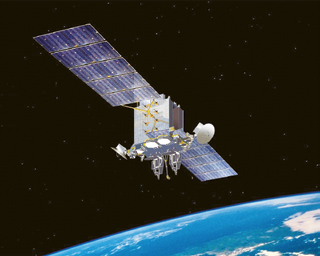
Artistic rendition of a Lockheed Martin built AEHF satellite
on-orbit. Image is
A4 OOT was the first test to have all six AEHF operational terminals communicating over XDR.
The terminal types include AEHF SMART-T, FAB-T, MMPU, NMT, Global ASNT and ACF-IC2.
The addition of AEHF-4 to the constellation provides a new capability of global extended data rate (XDR) communications. XDR communications provides data rates to its users five times higher than medium data rate (MDR) and 350 times higher than low data rate (LDR) communications.
Milstar, the predecessor to AEHF, uses both LDR and MDR communication modes to directly support the warfighter.
This was the last step before control authority of the satellite is handed over to the U.S. Air Force SMC where it will join the combined AEHF-Milstar constellation.
The AEHF constellation provides global, survivable, highly secure and protected communications for strategic command and tactical warfighters operating on ground, sea and air platforms.
The jam-resistant system also serves international partners including Canada, the Netherlands and the United Kingdom.
Mike Cacheiro, VP of Protected Communications for Military Space, said this is a major milestone to celebrate with the customers at Space and Missiles Systems Center (SMC), the U.S. Air Force and teammates Northrop Grumman, L3 Communications and Aerojet.
As the company turns the focus on launching AEHF-5 in June, one month early, congratulations to everyone involved in completing this one of a kind, high-performance network in space.
This is a tremendous accomplishment for the AEHF program.
www.lockheedmartin.com/en-us/products/aehf.html
United Launch Alliance Delta IV takes the USAF WGS-10 satellite to orbit
A United Launch Alliance (ULA) Delta IV rocket carrying the tenth Wideband Global SATCOM (WGS) satellite for the U.S. Air Force lifted off from Space Launch Complex-37 on March 15 at 8:26 p.m. EDT. ULA has been the exclusive launch provider for all ten WGS satellites.
“We are very proud to deliver this critical asset to orbit in support of the U.S. and Allied warfighters deployed around the world defending our national security,” said Gary Wentz, ULA vice president of Government and Commercial Programs. “Thank you to the entire ULA team and mission partners for their outstanding teamwork and dedication to mission success.”
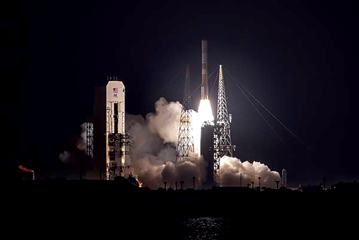
The WGS-10 satellite, built by the Boeing Company, is an important element of the new high-capacity satellite communications system. Each WGS satellite provides more wideband communications capacity than the entire Defense Satellite Communications System.
This mission launched aboard a Delta IV Medium+ (5,4) configuration vehicle, built in Decatur, Alabama, including a 5-meter Payload Fairing and standing at 218 feet. The common booster core for Delta IV was powered by the RS-68A engine, and the Delta Cryogenic Second Stage was powered by the RL10B-2 engine, both supplied by Aerojet Rocketdyne. Northrop Grumman provided the four solid rocket motors. At liftoff, the main engine and four solid rocket motors combined to produce approximately 1.7 million pounds of thrust.
To date, ULA has a track record of 100 percent mission success with 133 successful launches.
With more than a century of combined heritage, ULA is the world’s most experienced and reliable launch service provider. ULA has successfully delivered more than 130 satellites to orbit that provide Earth observation capabilities, enable global communications, unlock the mysteries of our solar system, and support life-saving technology.
www.unitedlaunchalliance.com
DISA awards Iridium with EMSS ground site contract
Iridium Communications Inc. (NASDAQ: IRDM) has been awarded a new contract by the Defense Information Systems Agency (DISA) to continue supporting the U.S. Department of Defense (DoD) Enhanced Mobile Satellite Service (EMSS) gateway.

The contract, valued at $54 million over 4.5 years, for Gateway Maintenance and Support Service (GMSS), will ensure that this dedicated ground site continues to operate at peak efficiency and in optimal condition for critical U.S. DoD missions.
Dedicated for use by the U.S. DoD, their Iridium gateway serves as the uplink and downlink point for the DoD’s EMSS communications capabilities through the Iridium® network.
This includes the enhanced capabilities made possible by Iridium’s upgraded satellite constellation, which was formally completed and declared fully operational in February of this year.
The previous iteration of the GMSS contract was awarded in October of 2013 for a five-year term with a sixmonth extension option.
The subscribers operating under the Iridium EMSS program run by DISA have more than doubled over the five-year period between 2013 and 2018 to 113,000, reflecting a 17.25 percent compounded annual growth rate.
This surge in growth has occurred under the current flat-rate contract program that provides unlimited voice and data services to the U.S. warfighter and other government participants.
Scott Scheimreif, EVP of government programs, Iridium, said this new contract provides the mechanism for Iridium to help ensure the DoD gateway is able to fully support the new capabilities and services needed to meet the emerging requirements of the warfighter. Scott added that this is another example of the strategic, long-term relationship between Iridium and the U.S. Department of Defense. The company remains committed to the U.S. DoD and the warfighter as new ways for addressing critical requirements leveraging Iridium’s unique satellite network are explored.
www.iridium.com
GetSAT’s MilliSAT terminals receive an Inmarsat blessing
GetSAT has reported that Inmarsat has type approved the company’s MilliSAT-H-GX and MilliSAT-W-GX for use on its Global Xpress service.
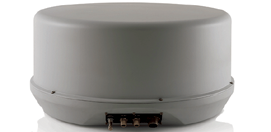
These new terminals, according to the company, are the lightest and most compact all in one on-the-move solutions serving the Global Xpress high-throughput, global network.
Leveraging GetSAT’s highly efficient, patented InterFLAT miniaturized flat panel antenna technologies, these MilliSAT-H-GX and MilliSAT-W-GX are the first Communications-On-The-Move (COTM) terminals for ground vehicles using the worldwide Global Xpress network.
These ruggedized terminals have been proven to operate in some of the toughest environmental conditions. Their combination of size, weight, and fast-tracking technology allows for operation on land-mobile and maritime platforms with aggressive vehicle dynamics.
Size and weight limitations have traditionally been a challenging requirement for land-mobile SATCOM applications. The size and weight of the MilliSAT-H-GX and MilliSAT-W-GX make these terminals well suited for widespread adoption in the land mobile market.
The MilliSAT-H-GX’s 25x27 cm. flat panel antenna fits inside a 40 cm. radome allowing easy installation. Additionally, the terminals’ low power consumption allows for battery operation, adding greatly to their flexibility. With industry leading SWaP (Size, Weight and Power), the units set a new standard for small, Inmarsat type-approved for SATCOM terminals used with Global Xpress.
GetSAT CEO, Kfir Benjamin, said the company is pushing the innovation envelope in creating — and constantly delivering — the industry’s most miniaturized terminals for airborne, ground and maritime on-the-move applications. The firm’s mission to craft micronized technologies to support a small flat panel enables the company’s team to consistently find new ways to successfully reduce terminal size while maintaining strength and power. Our MilliSAT-H-GX and MilliSAT-W-GX terminals were developed to meet Inmarsat’s exacting standards and provide users with ease of use.
Steve Gizinski, Chief Technology Officer, Inmarsat Government, added that Global Xpress has drawn a significant number of commercial and government customers due to its unique reliability, ease of use and seamless interoperability with military satellite resources. With the Inmarsat type approval of GetSAT’s terminals, ground and maritime on the move users have access to a very compact terminal to support their critical connectivity requirements.
www.getsat.com/products/millsat-w-lm/
www.inmarsat.com/service/global-xpress/
First production representative of Northrop Grumman’s EOC is delivered to the U.S. Army
Northrop Grumman Corporation (NYSE: NOC) has delivered to the U.S. Army the first production-representative engagement operations center (EOC) for the Integrated Air and Missile Defense (IAMD) Battle Command System (IBCS).
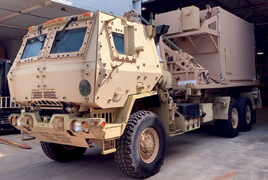
The delivered IBCS EOC has completed all functional configuration audits for major configuration items and system verification review, and is representative of the production configuration for hardware and software that will undergo qualification testing before IOT&E.
Northrop Grumman is on pace to deliver 11 EOCs and 18 IFCN relays for the IBCS program by the end of the year.
IBCS is a paradigm shift for IAMD by replacing legacy stove-piped systems with a next-generation, net-centric approach to better address an evolving array of threats. The system integrates disparate radars and weapons to construct a far more effective IAMD enterprise. IBCS delivers a single integrated air picture with unprecedented accuracy as well as broader surveillance and protection areas. With its truly open systems architecture, IBCS allows incorporation of current and future sensors and effectors and enables interoperability with joint C2 and the ballistic missile defense system.
IBCS is managed by the U.S. Army Program Executive Office for Missiles and Space, Redstone Arsenal, Alabama.
Dan Verwiel, VP and GM, missile defense and protective systems, Northrop Grumman, said this milestone is testament of the significant progress toward operational capability that will make pivotal differences to warfighters, commanders and acquisition officials.
The company will be delivering more EOCs as well as IBCS integrated fire control network (IFCN) relays in the near future. These articles will be used for initial operational test and evaluation (IOT&E), which informs future production decisions.
www.northropgrumman.com
Harris receives contract to strengthen GPS IIIF satellites’ signals
Harris Corporation (NYSE: HRS) has received a $243 million contract from Lockheed Martin (NYSE:LMT) to provide fully digital navigation signals for the first two GPS III Follow-On (GPS IIIF) satellites to deliver stronger signals, with greater operational flexibility.
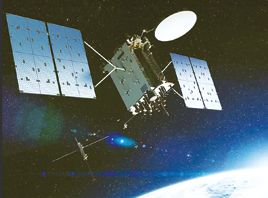
Harris’ GPS IIIF fully-digital Mission Data Unit (MDU), the heart of the satellite’s navigation payload which generates the GPS signals, will provide more powerful signals, assure flawless clock operations for GPS users, and add flexibility to adapt to advances in GPS technology, as well as future changes in mission needs.
It will provide improved capabilities over Harris’ 70 percent digital MDU used for GPS III Space Vehicles 01-10 (GPS III SV01-10). The new MDU also offers the U.S. Air Force a smooth transition to its GPS OCX ground control segment. Harris will seamlessly port its digital signal design, minimizing both integration risks and associated costs.
In September OF 2018, the U.S. Air Force (USAF) selected Lockheed Martin, with Harris as its navigation signal partner, to build up to 22 GPS IIIF satellites, with a total estimated contract value up to $7.2 billion. The USAF expects the first GPS IIIF satellite, SV11, to be available for launch in 2026.
Launched aboard GPS III SV01 in December 2018, Harris’ first GPS III navigation payload began broadcasting navigation signals on January 8. While testing of the first-of-its-kind satellite continues, the payload has performed beyond expectations. Harris has provided navigation technology for every U.S. GPS satellite ever launched, enabling the reliable GPS signal that millions of people — including U.S. soldiers — and billions of dollars in commerce depend on every day.
www.harris.com
SecureSync from Orolia is approved by DISA
Orolia’s SecureSync time and synchronization servers have been selected to support en route radar systems across the U.S.

The only Time and Synchronization Device approved by the Defense Information Systems Agency (DISA) for use in U.S. Government networks, SecureSync provides unparalleled reliability, security and flexibility to synchronize critical aviation operations.
The FAA employs a variety of radar types for short-, medium- and long-range air traffic control requirements.
These diverse radars require different types of timing signals and outputs to suit their operations. Orolia’s SecureSync provides the necessary timing outputs and signals required for these radars.

The time server’s outstanding ability to provide resilient, accurate and reliable timestamps for the data that it receives from radars is used to quickly organize the data for the aircraft control user interface.
Orolia was selected by the FAA for this competitive program based on its proven timing and synchronization technology, and its ability to offer multiple output options as COTS products that do not require additional research and development time or investment.
Only SecureSync combines multi-GPS/GNSS signal synchronization, options for alternative signals and BroadShield GPS anti-jamming/spoofing protection for transportation systems.
Jean-Yves Courtois, CEO of Orolia, stated that consistently accurate timestamps and the synchronization of thousands of real-time flight data points are essential for safe and efficient en route air traffic operations. The company is proud to support the FAA’s radar data and aircraft control user interface requirements to improve air travel services nationwide.
www.satnews.com/solutions/aerospace/aviation-programs



